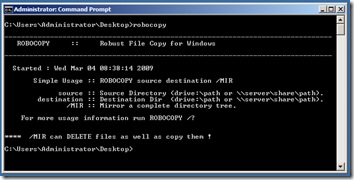
The second parameter is always the destination location.
I will not likely have the shares built yet on the new server.  It will likely have a newer version of Robocopy installed and. I typically always run Robocopy from the new file server as: The first parameter is always the source location. Over the years of usage, I have found this syntax the one I keep going back to over and over again: Be careful with some of the options if you are just trying it out, as some of them move the data (deleting the files and folders in the source location or the target location). There are quite a few options when it comes to file server migrations using Robocopy, and you might not know where to start. So, chances are if you start a command prompt on your computer and type “robocopy /?” you’ll see the help dump of information to your screen on how to use the utility. Beginning in 2008 (and thereafter), it was bundled with both desktop and server operating systems starting with Vista and Server 2008. Back then and until 2008, it was available with the Windows Resource Kit download. Robocopy has existed since NT4 days in 1996, so this is likely not the first time you are hearing of it. When the need arises to duplicate the data for the migration to the new server, I always go back to old faithful- Robocopy (Robust File Copy for Windows).
It will likely have a newer version of Robocopy installed and. I typically always run Robocopy from the new file server as: The first parameter is always the source location. Over the years of usage, I have found this syntax the one I keep going back to over and over again: Be careful with some of the options if you are just trying it out, as some of them move the data (deleting the files and folders in the source location or the target location). There are quite a few options when it comes to file server migrations using Robocopy, and you might not know where to start. So, chances are if you start a command prompt on your computer and type “robocopy /?” you’ll see the help dump of information to your screen on how to use the utility. Beginning in 2008 (and thereafter), it was bundled with both desktop and server operating systems starting with Vista and Server 2008. Back then and until 2008, it was available with the Windows Resource Kit download. Robocopy has existed since NT4 days in 1996, so this is likely not the first time you are hearing of it. When the need arises to duplicate the data for the migration to the new server, I always go back to old faithful- Robocopy (Robust File Copy for Windows). 
However, this process only works elegantly when the file share data exists on a volume that isn’t where Windows or any applications are installed. It is also generally very quick as there is no need to copy terabytes of data from one server to another. This maintains NTFS permissions if both servers are members of the same Active Directory domain.

Sometimes if the server doesn’t have any other roles or functions installed other than just a file server, then I could simply unshare the shares on the original server, detach the virtual hard disk from it, attach the virtual hard disk to the new server, and reshare the shares. With various flavors of Windows Server operating systems going out of support this year, I have found myself with a decent number of file server migrations from one system to another.







 0 kommentar(er)
0 kommentar(er)
